Managing Negative Balances and Bookkeeping in Your Amazon Business: What Happens When You Owe Money to Amazon
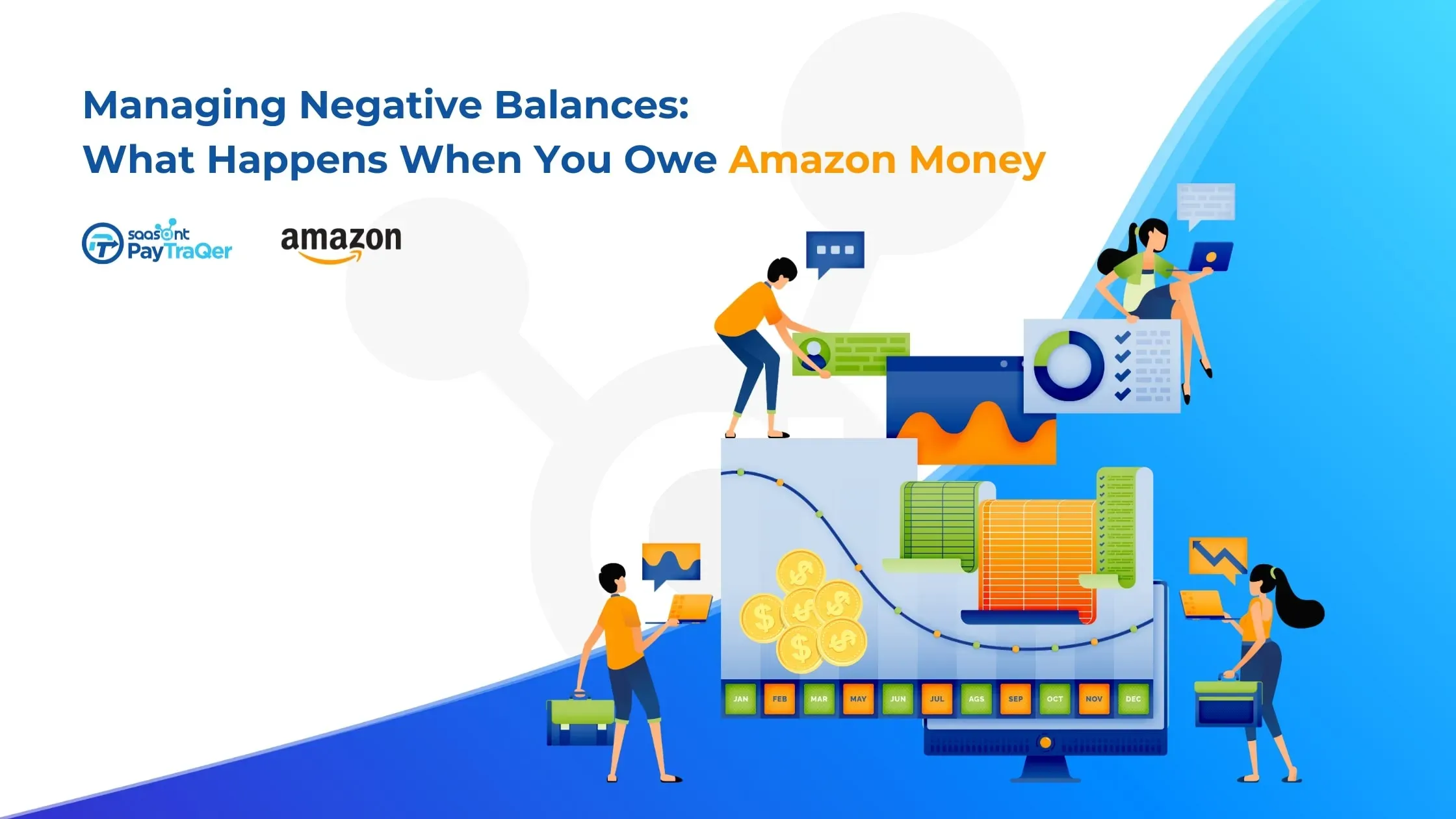
As an Amazon seller, it's critical to keep a watchful eye on your account balance. Failure to do so can result in owing Amazon money, which can have serious consequences for your business.
Unfortunately, owing money to Amazon is a common issue that many sellers face. It can happen for a variety of reasons, such as unexpected fees, returns, or chargebacks. It's not uncommon for sellers to find themselves in a negative balance, which can be stressful and confusing.
To avoid finding yourself in a similar situation, it's essential to understand what happens when you owe Amazon money, how to pay off negative balances, and the importance of bookkeeping in managing your Amazon business.
This article will provide a comprehensive guide to help you navigate the complexities of owing money to Amazon, as well as provide tips for effective bookkeeping practices to help you avoid negative balances in the first place.
Whether you're a seasoned Amazon seller or just getting started, it's crucial to stay informed and proactive when it comes to managing your account balance. By understanding the ins and outs of owing money to Amazon and practicing good bookkeeping habits, you can help ensure the long-term success of your Amazon business.
"If you also use Amazon for your business, either as a seller or to buy stock and supplies, it is not just about getting the payment method to work. Every purchase or payout eventually has to land in your accounting system. If you use QuickBooks Online, you can connect Amazon with QuickBooks using PayTraQer so that Amazon sales and fees are synced automatically."
Contents
Owing Money to Amazon
How to Pay Amazon Negative Balance
Bookkeeping for Amazon Business
Refunds on Amazon
Conclusion
Owing Money to Amazon
Amazon has various fees and charges that sellers need to pay. These fees include referral fees, fulfillment fees, and storage fees, among others. If a seller does not pay these fees or if there are refunds or chargebacks, the seller's account can go into a negative balance.
A negative balance means that the seller owes Amazon money. This can have significant consequences for your business, including the suspension of your account, the withholding of payments, and legal action against you.
What happens if you owe Amazon money?
Owing money to Amazon can have serious consequences for a seller, as it can result in account suspension, loss of sales, and even legal action. Amazon has strict policies in place to protect its platform and ensure that sellers are meeting their financial obligations. When a seller owes Amazon money, the company will take swift action to resolve the situation.
The first step Amazon takes is to notify the seller that they have a negative balance on their account. This notification is sent via email and is also visible in the seller's dashboard on Seller Central. Sellers are given seven days to pay the debt before Amazon takes action against the account.
If the negative balance is not resolved within the given time frame, Amazon can place a hold on the seller's payments. This means that Amazon will not release any payments until the debt is paid off. In extreme cases, Amazon may even withhold payments indefinitely until the negative balance is resolved.
If the seller still fails to resolve the negative balance, Amazon can suspend their account. This can result in the loss of sales and damage to the seller's reputation, as their products will no longer be available for purchase on Amazon's platform.
Additionally, Amazon may take legal action against the seller to recover the debt, which can have serious financial and legal consequences.
How do you know if you owe Amazon money?
Monitoring the financial health of an Amazon account is crucial for every seller. Keeping track of all transactions and sales can help avoid negative balances and potential account suspension. Amazon's Seller Central dashboard provides a detailed transaction report that shows all fees, charges, refunds, and credits applied to the seller's account.
This report can be accessed under the Payments tab. To determine if a seller owes Amazon money, they should review this report regularly. The report provides a clear view of the account balance and all transactions, including refunds and chargebacks.
Sellers can also track the payment status of their orders in the Orders tab of the Seller Central dashboard. They should take prompt action to pay off the balance to avoid potential account suspension or legal action. Additionally, sellers can set up automatic payments to ensure that fees are paid on time and to avoid any negative balances.
Can Amazon Pay balance be negative?
Amazon Pay balance is an essential aspect of selling on Amazon. It's a payment service that enables customers to make online purchases through their Amazon account. Amazon Pay balance can be used to pay for purchases on Amazon and other third-party websites that accept Amazon Pay.
It's a convenient payment option for customers, and it's a way for sellers to receive payments. However, Amazon Pay balance can also have a negative balance if a seller owes Amazon money.
The negative balance can occur due to various reasons, such as fees, charges, refunds, or other payments that have not been properly credited. The negative balance can have significant consequences for the seller's account and business.
Here are some things to keep in mind about negative Amazon Pay balance:
1. Negative balance notification: Amazon will notify the seller via email if the account has a negative balance.
2. Amazon can deduct future payments: If a seller's account has a negative balance, Amazon will deduct any future payments or funds received from the account until the negative balance is paid off.
3. Importance of monitoring Amazon Pay balance: Sellers should monitor their Amazon Pay balance regularly to avoid negative balances and ensure that they have enough funds to cover any fees or charges.
Can Amazon legally hold your money?
Yes, Amazon can legally hold a seller's money under certain circumstances. The company has a right to do so to protect its customers and prevent fraud.
Here are some situations where Amazon may legally hold a seller's money:
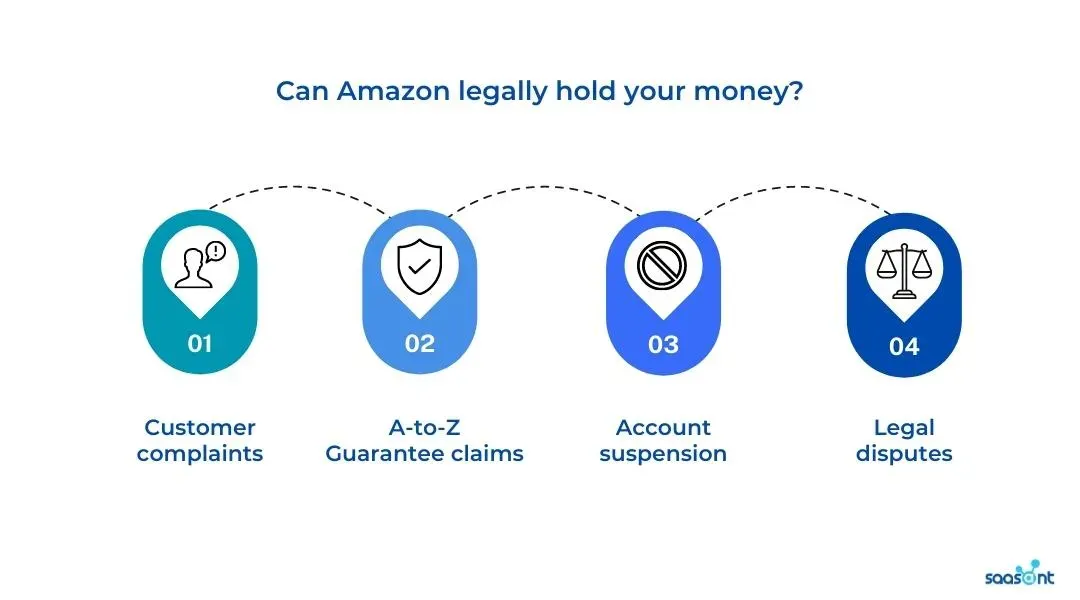
1. Customer complaints: If a customer complains about a product, Amazon may refund the customer without seller approval. The refund will be taken from the seller's account balance, and Amazon may hold any future payments to cover the cost of the refund.
2. A-to-Z Guarantee claims: Amazon's A-to-Z Guarantee program protects customers who purchase products from Amazon. If a customer files an A-to-Z Guarantee claim against a seller, Amazon may hold funds in the seller's account until the dispute is resolved.
3. Account suspension: If Amazon suspends a seller's account due to policy violations, it may hold funds in the account for up to 90 days. This is to ensure that the seller can fulfill any outstanding orders and provide refunds to customers before the account is permanently closed.
4. Legal disputes: If a seller is involved in a legal dispute with Amazon, the company may hold funds in the account until the dispute is resolved.
It's essential for sellers to understand these situations and take steps to avoid them whenever possible. By providing excellent customer service and following Amazon's policies, sellers can reduce the risk of funds being held in their accounts.
Can Amazon shut down or ban your seller account?
Yes, Amazon has the right to shut down or ban a seller's account if they violate Amazon's policies or fail to resolve negative balances on the account. Here are some of the reasons why Amazon may shut down or ban a seller's account:
1. Violation of policies: Amazon has strict policies that sellers must follow. If a seller violates any of these policies, Amazon may shut down their account. Examples of policy violations include selling counterfeit products, manipulating customer reviews, and providing inaccurate product information.
2. Failure to resolve negative balances: If a seller does not pay off negative balances on their account or resolve other financial issues, Amazon may suspend or ban their account.
3. Poor performance metrics: Amazon monitors a seller's performance metrics, such as order defect rate and late shipment rate. If a seller consistently has poor metrics, Amazon may suspend or ban their account.
Some of those metrics are:
Late shipment rate should be below 4%
Pre-fulfillment cancel rate should be less than 2.5%
Order defect rate less than 1%.
Not meeting up with these metrics can lead to account suspension
4. Intellectual property infringement: If a seller is accused of infringing on someone else's intellectual property, such as using copyrighted images without permission, Amazon may shut down their account.
How to Pay Amazon Negative Balance
Understanding negative order total on Amazon
Negative order total on Amazon can be a cause of concern for sellers, especially if they are not familiar with the concept. It is important to understand that a negative order total can result from a variety of factors, and prompt action must be taken to resolve the situation.
1. Request for refund by customer: One common scenario where a negative order total occurs is when a buyer requests a refund or a credit for a purchase. When this happens, Amazon deducts the refund or credit amount from the seller's account.
If the refund or credit amount is greater than the original order total, the seller's account will have a negative balance.
2. Deduction of Amazon Fees and Charges: Another scenario where a negative order total can occur is when Amazon deducts fees, charges, or other amounts from the seller's account.
For example, Amazon charges fees for each transaction processed on its platform, and if the seller's account does not have enough funds to cover these fees, it can result in a negative balance.
It is important for sellers to regularly review their transaction reports to stay on top of any negative balances on their account. This will help them take prompt action to resolve the situation before it escalates.
When a negative balance is detected, sellers can take the following steps to resolve it:
1. Add funds to the Amazon account: If the negative balance is not too high, sellers can add funds to their Amazon account to bring it back to positive standing.
2. Resolve any outstanding issues: Sellers should check their transaction reports to see if there are any outstanding issues, such as disputes or chargebacks, that need to be resolved.
3. Contact Amazon Seller support: If the negative balance is a result of an error or mistake, sellers can contact Amazon Seller support to resolve the issue.
A negative order total on Amazon can be a cause of concern for sellers. However, by understanding the reasons behind it and taking prompt action to resolve the situation, sellers can avoid account suspension or other consequences.
Regularly reviewing transaction reports and adding funds to the account when necessary can help sellers stay on top of their finances and maintain a positive standing on Amazon.
If you owe Amazon money, it's essential to take prompt action to bring the account back into positive standing.
Here's how to pay a negative balance on Amazon:
Go to the Seller Central dashboard and click on "Payments."
Click on "View Balance Summary" to see the account's current balance.
Click on "Make a Payment" to pay the negative balance.
Enter the amount of the payment and select a payment method.
Click "Submit Payment" to complete the payment process.
Confirm the payment and check the account's balance to ensure that it's back in positive standing.
How to calculate your balance if there is a negative balance involved
Calculating your balance on Amazon can be confusing, especially if there is a negative balance involved. Here are some steps to help you calculate your balance correctly:
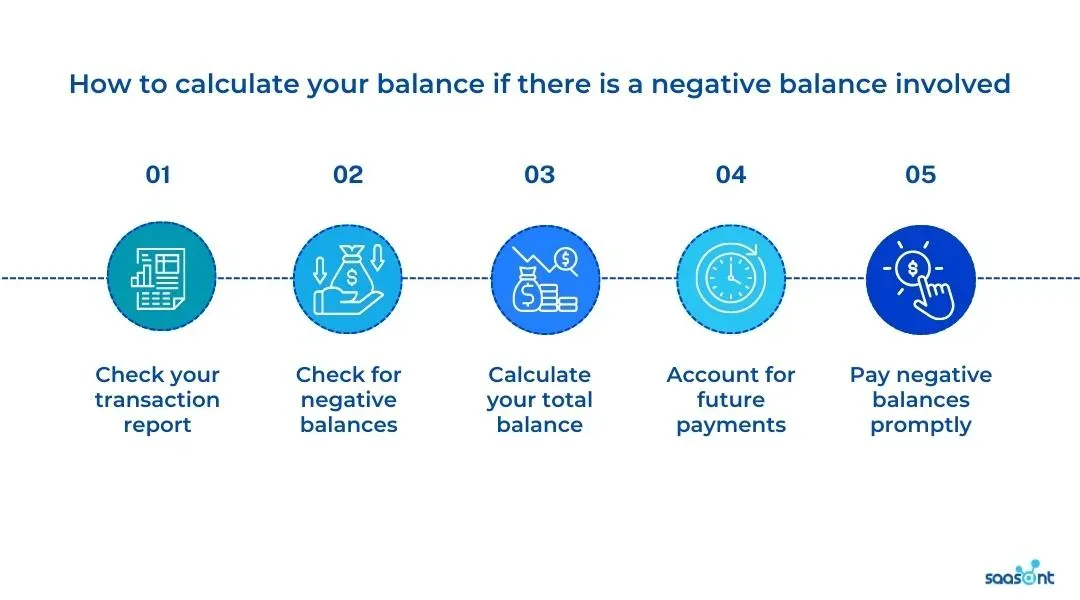
1. Check your transaction report: Your transaction report is a detailed breakdown of all the fees, charges, refunds, and credits applied to your account. You can use this report to determine your current balance.
2. Check for negative balances: A negative balance can occur if there are refunds or credits applied to your account that exceed your order total or if Amazon deducts fees or charges from your account. You can identify a negative balance by looking for a negative sign (-) next to your balance.
3. Calculate your total balance: To calculate your total balance, add up all the positive amounts in your transaction report and subtract any negative balances.
4. Account for future payments: If you have a negative balance, Amazon may deduct any future payments or funds received from your account until the negative balance is paid off. To avoid further negative balances, factor in any future payments you expect to receive when calculating your balance.
5. Pay off negative balances promptly: If you have a negative balance, it's important to pay it off promptly to avoid account suspension or other consequences. You can make a payment by going to the "Payments" tab in Seller Central and selecting "Make a Payment."
Payment methods available
Amazon provides multiple payment methods for sellers to pay off their negative balances. Here are some payment methods available to sellers:
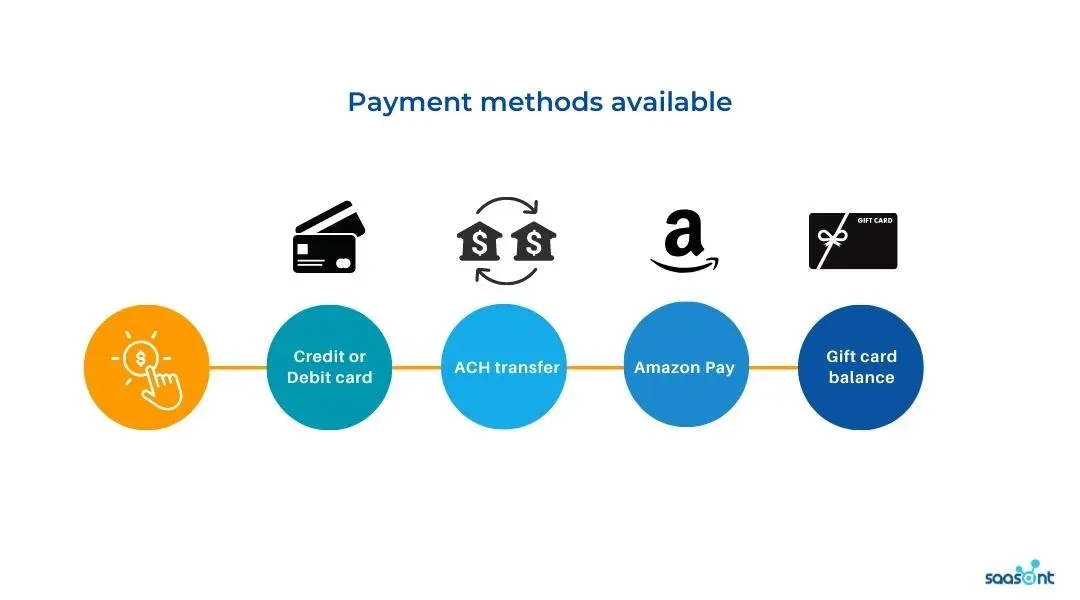
1. Credit or Debit card: Sellers can use a credit or debit card to make payments on their Amazon seller account. This method allows for quick and easy payment processing and is a popular choice among sellers.
2. ACH transfer: ACH transfer is a bank-to-bank electronic transfer that can be used to pay off negative balances. This method can take a few business days to process, but it's a secure and reliable payment method.
3. Amazon Pay: Amazon Pay is another payment option available to sellers. Sellers can use their Amazon Pay balance to pay off negative balances. However, if the Amazon Pay balance is not sufficient to cover the negative balance, the seller will need to use an alternative payment method.
4. Gift card balance: Sellers can also use their gift card balance to pay off negative balances on their Amazon seller account. This is a convenient payment method, especially for those who have accumulated gift cards over time.
Tips for avoiding negative balances
Avoiding negative balances on your Amazon seller account is crucial to maintaining a positive reputation and preventing potential consequences such as account suspension or legal action. Here are some tips to help you avoid negative balances:
Monitor your account regularly: Check your account regularly to ensure that all fees, charges, and refunds are accurate. This will help you identify any issues quickly and take prompt action.
Keep track of your inventory: Make sure that your inventory is accurate and up-to-date. If you oversell a product, you may need to issue refunds, which can result in a negative balance.
Set accurate prices: Make sure that your product prices are accurate and reflective of your costs. Setting prices too high may result in low sales, while setting them too low may result in a loss.
Use Amazon's tools: Amazon provides various tools such as the Automate Pricing tool that helps you set prices automatically and stay competitive. Additionally, use Amazon's fee calculators to understand the fees associated with selling on Amazon.
Fulfill orders promptly: Amazon rewards sellers who fulfill orders promptly by giving them higher ratings, which can lead to increased sales. Delayed orders can result in negative feedback and refunds, which can impact your account balance.
Provide excellent customer service: Ensure that you communicate promptly and clearly with your customers. Respond to queries and concerns quickly, and address any issues promptly.
Bookkeeping for Amazon Business
Importance of bookkeeping in Amazon business
Bookkeeping is an essential part of any business, including Amazon seller accounts. Effective bookkeeping provides sellers with a clear and accurate picture of their business finances, including sales, expenses, profits, and losses.
It allows sellers to monitor their financial performance, identify areas for improvement, and make informed decisions about their business. In the case of owing money to Amazon, accurate bookkeeping is crucial to staying on top of fees, charges, and refunds.
Without proper bookkeeping, it's easy to overlook negative balances or miss payments, which can lead to account suspensions, withheld payments, and legal action. Additionally, bookkeeping can help sellers prepare for tax season by tracking sales and expenses, ensuring they pay the correct amount of taxes, and avoiding any penalties or fines from the IRS.
It can also provide valuable insights into which products are selling well and which are not, allowing sellers to adjust their business strategies accordingly.
How bookkeeping can help you avoid negative balances
Bookkeeping is essential in any business, including Amazon, as it helps sellers to keep track of their finances and avoid negative balances. Here are some ways bookkeeping can help:
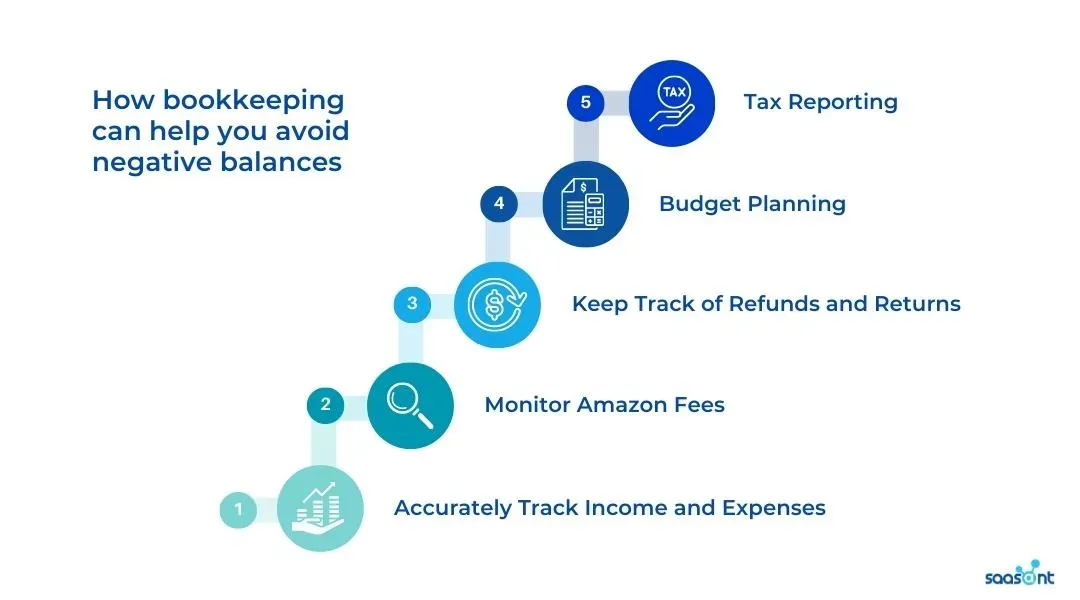
1. Accurately Track Income and Expenses: Bookkeeping ensures that all sales and expenses are accurately recorded, enabling sellers to know the exact amount of money they have earned or spent. With this information, sellers can avoid overspending or underestimating their expenses, which can lead to a negative balance.
2. Monitor Amazon Fees: Amazon charges various fees to sellers, such as referral fees, fulfillment fees, and storage fees. Bookkeeping helps sellers keep track of these fees and ensures that they are accurately recorded. This helps sellers to understand their true profit margins and avoid a negative balance.
A very useful tool for monitoring your Amazon fees is PayTraQer by SaasAnt. This tool helps to automatically import your Amazon fees into accounting software like QuickBooks and Xero. With an unlimited history functionality, you can easily sync your payment for proper bookkeeping.
3. Keep Track of Refunds and Returns: Refunds and returns can also lead to negative balances if not properly recorded. Bookkeeping helps sellers to track these transactions and ensures that the refunds or returns are accurately recorded in the seller's account.
4. Budget Planning: Bookkeeping helps sellers to create and maintain a budget, which is crucial in avoiding negative balances. By monitoring expenses and income, sellers can plan for the future and avoid overspending.
5. Tax Reporting: Bookkeeping also helps sellers to accurately report their income and expenses to the tax authorities. By keeping accurate records, sellers can avoid fines or penalties and maintain a positive balance.
Basic bookkeeping principles for your Amazon Business
Here are some basic bookkeeping principles that sellers should keep in mind:
Keep detailed records: Accurate records of sales, expenses, refunds, and other financial transactions are critical for tracking business performance and making informed decisions.
Separate business and personal finances: Amazon sellers should maintain separate bank accounts and credit cards for their business to avoid mixing personal and business finances.
Use accounting software: Accounting software like QuickBooks or Xero can help automate bookkeeping tasks, track expenses, and generate financial reports.
Reconcile accounts: Regularly reconciling accounts ensures that all transactions are accurately recorded and can help identify errors or discrepancies.
Monitor cash flow: Monitoring cash flow helps sellers stay on top of income and expenses and ensures that there is enough cash available to cover expenses and avoid negative balances.
Refunds on Amazon
Amazon's refund policy
Amazon's refund policy is designed to protect customers and ensure their satisfaction with their purchases. The policy covers most products sold on Amazon, including those sold by third-party sellers, and applies to all orders shipped to the US, Canada, and Europe.
Here are some important things to know about Amazon's refund policy:

1. Eligibility: Most items sold on Amazon are eligible for a refund. However, there are some exceptions, such as digital content, certain subscription services, and customized or personalized products.
2. Timeframe: Customers have 30 days from the date of delivery to initiate a refund request. After 30 days, customers may still be eligible for a refund in certain circumstances, such as if the item is defective or not as described.
3. Return process: To initiate a refund request, customers can go to the "Your Orders" section of their Amazon account and select the item they wish to return.
They will then be prompted to select a reason for the return and may be asked to provide additional information. After the return is approved, the customer will receive instructions on how to return the item.
4. Refund options: Depending on the payment method used for the original purchase, customers may receive their refund in the form of an Amazon gift card or credit to their original payment method. Some refunds may take several business days to process.
5. Third-party sellers: If an item is sold by a third-party seller on Amazon, the seller's return policy may apply. However, Amazon requires all third-party sellers to follow certain guidelines, such as offering a return window of at least 30 days and providing a return shipping label.
What happens if you get a refund on Amazon?
If a buyer receives a refund on Amazon, the amount of the refund will be deducted from the seller's account. This deduction can result in a negative balance on the seller's account if the amount of the refund is greater than the original order total.
When a refund is issued, Amazon will notify the seller via email and in the Seller Central dashboard. The email will include information on the refund, including the reason for the refund and the amount.
The Seller Central dashboard will show the details of the refund, including the product, the reason for the refund, and the amount deducted from the seller's account. If a seller's account has a negative balance due to a refund or other charge, Amazon will deduct future payments or funds received from the account until the negative balance is paid off.
Sellers should monitor their account regularly to ensure that there are no negative balances and take prompt action to resolve any negative balances that do occur. Failure to pay off a negative balance can result in account suspension or other consequences.
What to do if you get a refund but package came
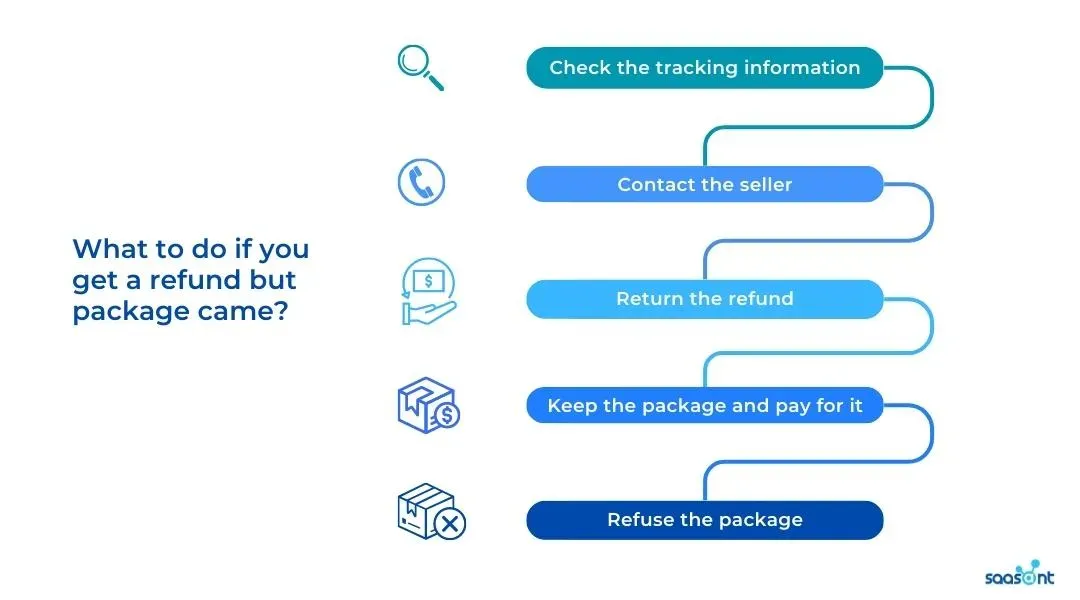
If a customer receives a refund from Amazon for an order, but the package arrives later, there are a few steps that they can take to resolve the issue. Here are some tips for what to do if you get a refund but the package comes later:
1. Check the tracking information: The first step is to check the tracking information for the package. This can help to determine if there was a delay in shipping or if the package was lost in transit.
2. Contact the seller: If the package arrives after the refund has been issued, the customer can contact the seller to inform them of the situation. The seller may be willing to work with the customer to cancel the refund and reinstate the order.
3. Return the refund: If the customer has already received the refund, they can return it to Amazon by following the steps outlined in the refund notification email. This will allow them to reinstate the order and pay for the item.
4. Keep the package and pay for it: If the customer is unable to cancel the refund or return it to Amazon, they can choose to keep the package and pay for it separately. They can do this by placing a new order for the same item and paying for it with a different payment method.
5. Refuse the package: If the customer no longer wants the package, they can refuse the delivery when it arrives. This will result in the package being returned to the seller, and the customer may be eligible for a refund once the seller receives the package.
It's important to note that each situation may be different, and the best course of action will depend on the specific circumstances. In some cases, it may be possible to work with the seller or Amazon customer service to find a resolution. The key is to communicate with the appropriate parties and take action as soon as possible.
Conclusion
Owing money to Amazon can have significant consequences for a seller's business, and it's crucial to stay on top of fees, charges, and refunds to avoid a negative balance. Understanding Amazon's refund policy is also vital to avoid any confusion or issues that may arise.
Effective bookkeeping practices can help Amazon sellers keep track of their finances and avoid negative balances. This includes regularly reviewing transaction reports, reconciling accounts, and keeping accurate records of all income and expenses.
Furthermore, tools like PayTraQer and SaasAnt Transactions can help sellers streamline their bookkeeping process and identify any outstanding debts owed to Amazon. These software solutions integrate with Amazon's platform to provide real-time financial data, automated transaction categorization, and customizable reports.
In the case of refunds, it's essential to communicate with the buyer to resolve any issues and ensure that the item is returned or paid for promptly. Keeping track of refunds and credits in bookkeeping records can help avoid any confusion or discrepancies.